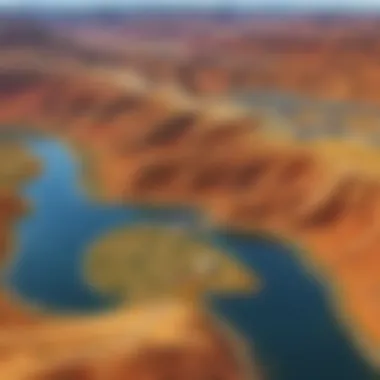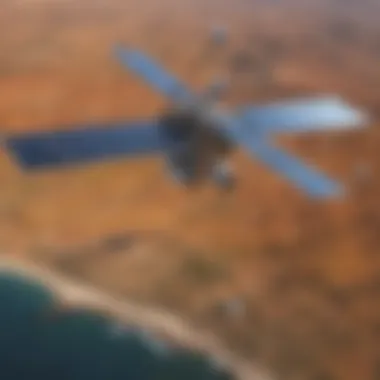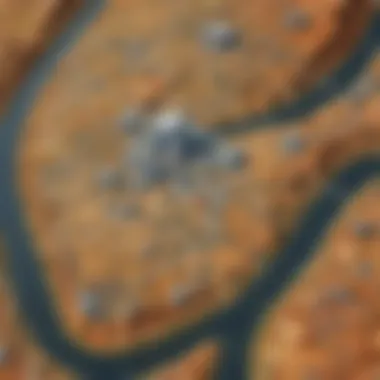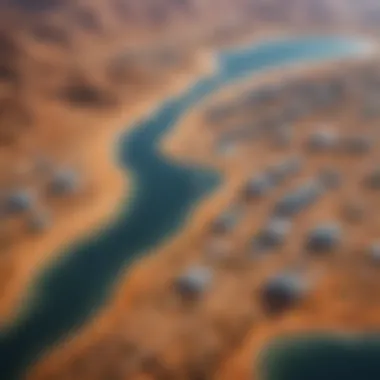Unveiling the Intricacies of Remote Sensing: An Extensive Guide


Understanding Remote Sensing Technology
In the vast expanse of technological innovation, remote sensing stands as a cornerstone in the realm of data collection and analysis. The foundational knowledge of remote sensing is essential to grasp its complexities fully. Its utilization spans a broad spectrum of fields, from environmental monitoring to urban planning, showcasing its versatility and critical importance in contemporary society. By delving into the intricate details of remote sensing technology, one can unravel the underlying principles that drive its applications and significance.
Definition and Scope of Remote Sensing
Remote sensing encompasses a diverse array of technologies and methodologies employed to gather data from a distance. From satellite imagery to aerial drones, remote sensing techniques facilitate the observation and measurement of Earth's surface and atmosphere. This practice allows for the acquisition of valuable information without direct contact, revolutionizing data collection processes across various industries.
Advanced Remote Sensing Applications
The evolution of remote sensing has paved the way for groundbreaking applications that go beyond mere data collection. Applications such as precision agriculture, disaster management, and climate modeling showcase the transformative power of remote sensing technology. By harnessing advanced data analytics and machine learning algorithms, remote sensing has the potential to revolutionize decision-making processes and enable proactive solutions to complex problems.
Overview of Remote Sensing Technologies
Navigating the intricate landscape of remote sensing technologies requires a comprehensive understanding of the tools and methodologies at one's disposal. From passive sensors that detect natural radiation to active sensors that emit energy pulses, each technology brings a unique set of capabilities to the table. Understanding the nuances of these technologies is crucial for leveraging their full potential in diverse applications.
Passive Remote Sensing Techniques
Passive remote sensing techniques rely on detecting and measuring natural radiation emitted or reflected by the Earth's surface. The utilization of multispectral and hyperspectral imagery enables detailed analysis of environmental factors such as vegetation health, land cover, and water quality. By harnessing the power of passive sensors, researchers can extract valuable insights from intricate data sets, enhancing their decision-making processes.
Active Remote Sensing Technologies
Contrary to passive techniques, active remote sensing technologies involve emitting energy pulses towards the Earth's surface and measuring their reflection. Radar and lidar systems are prime examples of active sensors that deliver precise elevation data, terrain mapping, and object detection capabilities. The integration of these technologies into remote sensing applications has unlocked new possibilities for scientific research, environmental monitoring, and infrastructure development.
Fusion of Remote Sensing Data
The fusion of data from multiple remote sensing sources offers a synergistic approach to data analysis and interpretation. By combining information from different sensors and platforms, researchers can enhance the accuracy and reliability of their findings. This integration facilitates a holistic understanding of complex phenomena, enabling comprehensive assessments and informed decision-making processes.
Significance of Remote Sensing in Modern Society
The profound significance of remote sensing in modern society transcends traditional boundaries, influencing diverse sectors ranging from agriculture to disaster response. Its intrinsic value lies in its ability to provide timely and accurate information for informed decision-making, thereby contributing to sustainable development and resource management. By harnessing the power of remote sensing technology, societies can address pressing challenges and pave the way for a more sustainable and resilient future.
In the vast universe of remote sensing lies a tapestry of intricate dimensions waiting to be explored. This guide endeavors to unveil the mysterious realm of remote sensing, shedding light on its essence, applications, technologies, and paramount significance. Every facet of this enigmatic field will be dissected meticulously, enabling readers to embark on a journey of discovery and enlightenment.
Introduction to Remote Sensing
Embarking on the voyage through remote sensing, we encounter the foundational bedrock upon which this field thrives. The introduction sets the stage for a profound exploration into remote sensing, laying bare its essence and unveiling the boundless possibilities it offers. Key elements such as definitions, core benefits, and critical considerations will be scrutinized in depth, providing a solid footing for readers to delve further.
Defining Remote Sensing
Theoretical Overview


Embedded within the realm of remote sensing lies the theoretical scaffolding that underpins its functioning. Delving into the theoretical overview, we unravel the specific aspects that form the backbone of this discipline. This section delves into the intricacies of remote sensing theory, elucidating its relevance and pivotal role in the broader landscape of scientific inquiry. Highlighting its unique characteristics and unparalleled advantages, we navigate through the theoretical landscape to grasp its essence and implications.
Operational Context
In the operational context of remote sensing, we navigate the practical realm where theory meets application. This segment bridges the gap between theoretical constructs and real-world implementation, showcasing how remote sensing operates in various settings. By dissecting its key characteristics and pragmatic significance, we gain a holistic understanding of remote sensing's operational dimension. The distinctive features of operational context shed light on its efficacy and constraints within the domain of remote sensing.
Evolution of Remote Sensing
As we trace the evolutionary trajectory of remote sensing, we uncover the metamorphosis that has propelled this field into the 21st century. The evolution of remote sensing encapsulates a rich tapestry of advancements, setbacks, and paradigm shifts that have shaped its current contours. By illuminating the key milestones and transformative developments, we unravel the intricate history that has sculpted modern remote sensing. Understanding the unique attributes and inherent challenges within this evolutionary saga equips us to appreciate the dynamic nature of remote sensing.
Importance of Remote Sensing
Traversing the terrain of significance, we encounter the profound impact remote sensing wields across multifarious domains. The importance of remote sensing transcends mere technology, embodying a transformative force that revolutionizes environmental monitoring, disaster management, and urban planning. Each aspect delves into specific applications that underscore the critical role remote sensing plays in enhancing decision-making and fostering sustainability.
Environmental Monitoring
Spearheading the realm of environmental vigilance, remote sensing emerges as a potent tool for monitoring ecological dynamics. By honing in on environmental monitoring, we unravel the instrumental role remote sensing plays in safeguarding the planet's fragile ecosystems. Analyzing its key characteristics and benefits illuminates how remote sensing bolsters conservation efforts and empowers policymakers with vital insights.
Disaster Management
In the crucible of crisis lies the pivotal role remote sensing assumes in disaster management scenarios. Exploring the domain of disaster response, we witness how remote sensing technologies serve as beacons of hope amidst chaos and uncertainty. Unveiling its unique features and operational advantages, we navigate through the intricacies of utilizing remote sensing for mitigating disasters and enhancing preparedness.
Urban Planning
Within the urban landscape, remote sensing emerges as a cornerstone for informed decision-making and sustainable development. Examining remote sensing's impact on urban planning, we uncover its transformative potential in mapping land use patterns and optimizing infrastructure layouts. By spotlighting its key attributes and operational nuances, we elucidate how remote sensing empowers urban planners to create resilient, future-ready cities.
Role of Remote Sensing in Various Fields
Venturing into the myriad domains where remote sensing holds sway, we unravel its versatile applications across agriculture, forestry, geology, and climate studies. Each domain presents a unique tapestry of challenges and opportunities, underscoring how remote sensing augments scientific inquiry and enhances problem-solving methodologies.
Agriculture
At the intersection of technology and agriculture lies the realm where remote sensing revolutionizes farming practices. Delving into the role of remote sensing in agriculture, we uncover its transformative impact on crop monitoring, yield optimization, and precision farming techniques. Analyzing its distinctive features and operational advantages, we demystify how remote sensing fosters agricultural sustainability and resilience.
Forestry
Within the verdant expanse of forests resides the profound influence remote sensing exerts on forestry management. Navigating through the lens of forestry, we unearth the indispensable role remote sensing plays in tracking deforestation, biodiversity conservation, and forest carbon monitoring. By delineating its key attributes and strategic advantages, we unravel how remote sensing bolsters forest conservation efforts and enables informed decision-making.
Geology
Beneath the earth's surface lies a treasure trove of geological phenomena waiting to be unraveled through the lens of remote sensing. Exploring the realm of geology, we delve into how remote sensing transforms mineral exploration, geological mapping, and hazard assessment processes. Examining its unique features and specialized applications, we illuminate how remote sensing enriches our understanding of geological processes and aids in resource management.
Climate Studies


In the crucible of climate dynamics, remote sensing emerges as a linchpin for monitoring global environmental changes. Traversing the landscape of climate studies, we unravel how remote sensing revolutionizes climate modeling, weather forecasting, and hazard prediction systems. By highlighting its critical characteristics and analytical prowess, we elucidate how remote sensing contributes to advancing climate science and fostering sustainable environmental practices.
Technologies in Remote Sensing
Remote sensing technologies play a pivotal role in modern-day data collection and analysis methodologies, especially in fields such as geography, environmental science, agriculture, and urban planning. In this article, we delve into the diverse technologies utilized in remote sensing, each offering unique benefits and considerations that contribute to a comprehensive understanding of this innovative field. Exploring these technologies allows us to appreciate their significance in capturing and interpreting data from a distance, enhancing our capabilities in various research and application domains.
Types of Remote Sensing Technologies
Passive Remote Sensing
Passive remote sensing is an inherent part of the remote sensing domain, involving the detection of natural energy reflected or emitted from the Earth's surface. Its non-intrusive nature enables the collection of valuable information without direct interaction, making it a popular choice for observing land cover, vegetation health, and atmospheric conditions. The key characteristic of passive remote sensing lies in its reliance on external radiation sources, such as sunlight, to illuminate and record data. This characteristic distinguishes passive sensing from active sensing methods, offering advantages like cost-effectiveness and continuous data acquisition. However, limitations include dependency on external light sources and reduced capability in adverse weather conditions. Despite these constraints, passive remote sensing remains a fundamental aspect of remote sensing technologies due to its versatility and widespread applications.
Active Remote Sensing
Contrary to passive sensing, active remote sensing involves the transmission of energy from a sensor towards the Earth's surface, with subsequent analysis of the reflected or backscattered signals. This active probing enables researchers to obtain information beyond surface features, penetrating vegetation canopies and detecting hidden objects. The primary characteristic of active remote sensing is its self-illumination, allowing for precise control over emitted energy and signal reception. This feature makes active sensing a preferred choice for applications requiring specific target detection or detailed topographic mapping. However, challenges such as energy consumption and signal processing complexity exist, impacting its practicality in certain scenarios. Despite these challenges, active remote sensing's versatility and ability to penetrate obstacles make it an indispensable tool in various remote sensing applications.
Sensor Systems
Sensor systems form the backbone of remote sensing technologies, encompassing a wide array of instruments designed to capture different types of data. The key characteristic of sensor systems lies in their ability to convert physical parameters into electrical signals, facilitating data acquisition and processing. Flexibility in sensor design and deployment allows for customized solutions tailored to specific research objectives, enhancing the precision and accuracy of collected data. Various sensor systems exhibit unique features such as multispectral imaging, thermal sensing, and LiDAR technology, each offering distinct advantages and disadvantages based on the intended application. Understanding the capabilities and limitations of sensor systems is essential for optimizing data collection strategies and ensuring the relevance of acquired information in remote sensing analysis.
Applications of Remote Sensing
In this article, the exploration of remote sensing applications delves into the significance and multifaceted utilization of this technology. Remote sensing plays a pivotal role in various fields, offering in-depth insights into environmental changes, disaster management, and urban planning. The comprehensive guide aims to shed light on how remote sensing serves as a critical tool for monitoring and analyzing different aspects of our surroundings, paving the way for informed decision-making and sustainable development.
Environmental Applications
Climate Change Monitoring
Climate change monitoring stands out as a crucial aspect of remote sensing applications, providing a unique perspective on environmental shifts and their impacts. By leveraging remote sensing technologies, experts can track changes in climate patterns, analyze temperature variations, and monitor ecosystem health with precision. This capability allows for early detection of climate-related phenomena, contributing to research efforts and proactive measures in tackling global environmental challenges.
Natural Resource Management
Within the realm of natural resource management, remote sensing plays a vital role in surveying and assessing various resources, including land cover, water bodies, and vegetation. The integration of remote sensing data aids in sustainable resource planning, ecosystem conservation, and optimizing resource utilization. By harnessing the power of remote sensing, stakeholders can make informed decisions regarding resource allocation and conservation practices, promoting environmental stewardship and biodiversity preservation.
Pollution Detection
Remote sensing technology facilitates effective pollution detection by enabling the monitoring of pollutants in the atmosphere, water bodies, and land surfaces. Through satellite imagery and sensor data analysis, remote sensing techniques detect sources of pollution, assess environmental damage, and support pollution management initiatives. The ability to identify pollution hotspots and trends aids in implementing targeted interventions to mitigate environmental degradation and safeguard public health.
Urban Planning and Development
Land Use Mapping
The application of remote sensing in land use mapping offers a comprehensive view of urban landscapes and spatial transformations. By capturing high-resolution images and spatial data, remote sensing enables the classification of land cover types, identification of land use patterns, and assessment of urban growth dynamics. This information is invaluable for urban planners, policymakers, and developers in optimizing land use strategies, infrastructure development, and urban expansion plans.


Infrastructure Planning
Remote sensing supports infrastructure planning by providing valuable insights into the design, construction, and maintenance of urban facilities and transportation networks. Through aerial surveys, LiDAR technology, and geospatial analysis, remote sensing allows for accurate mapping of infrastructure assets, monitoring structural changes, and assessing infrastructure vulnerabilities. This data-driven approach enhances the efficiency of infrastructure projects, promotes sustainable development practices, and enhances urban resilience to potential hazards.
Disaster Response and Preparedness
Early Warning Systems
Effective disaster response relies on early warning systems powered by remote sensing technologies to anticipate and mitigate potential risks. By monitoring environmental indicators, analyzing weather patterns, and detecting anomalies in the landscape, early warning systems facilitate timely alerts and evacuation strategies in the face of natural disasters. Remote sensing empowers emergency management agencies, governments, and humanitarian organizations to proactively prepare for and respond to emergencies, minimizing the impact on lives and properties.
Damage Assessment
Remote sensing aids in post-disaster damage assessment by providing rapid, accurate, and comprehensive data on the extent of destruction and infrastructure damage. Through satellite imagery, aerial surveys, and geospatial mapping, remote sensing techniques enable quick evaluation of affected areas, identification of critical infrastructure failures, and prioritization of relief efforts. By streamlining the damage assessment process, remote sensing plays a critical role in facilitating efficient recovery and reconstruction efforts in the aftermath of disasters.
Challenges and Future Trends
In this section, we delve into the pivotal aspect of Challenges and Future Trends within the realm of remote sensing. The significance of understanding the hurdles and upcoming advancements in remote sensing cannot be overstated. As technology continues to evolve rapidly, identifying and addressing challenges while anticipating future trends are essential for professionals in this field. By dissecting the limitations and advancements in remote sensing, we pave the way for innovation, efficiency, and progress.
Limitations of Remote Sensing
Cloud Cover
Cloud cover presents a fundamental challenge in remote sensing due to its interference with satellite imaging processes. The presence of clouds obstructs the acquisition of clear and accurate data from Earth's surface, affecting the quality and reliability of remote sensing outputs. Mitigating the impact of cloud cover remains a crucial focus for researchers and practitioners aiming to enhance remote sensing applications.
Spatial Resolution
Spatial resolution defines the level of detail captured in remote sensing imagery, influencing the accuracy and interpretability of the data. An optimal spatial resolution is vital for discerning intricate features on the Earth's surface. Balancing between high and low spatial resolution is a continual challenge, as it directly impacts the efficiency and effectiveness of remote sensing analyses.
Spectral Range
The spectral range determines the wavelengths of electromagnetic radiation captured by sensors in remote sensing devices. A broad spectral range enables the identification of diverse materials and phenomena on Earth, while a limited range may constrain the depth and precision of observations. Maximizing spectral range while managing trade-offs is critical for exploiting the full potential of remote sensing technologies.
Advancements in Remote Sensing
Hyperspectral Imaging
Hyperspectral imaging offers a revolutionary approach in remote sensing by providing detailed spectral information for each pixel in an image. This advanced technology enhances the discriminatory power of remote sensing data, enabling identification and analysis of materials based on their unique spectral signatures. The integration of hyperspectral imaging elevates the capabilities of remote sensing for a myriad of applications.
Unmanned Aerial Vehicles (UAVs)
Unmanned aerial vehicles, or UAVs, have propelled remote sensing to new heights by offering agile and adaptable platforms for data collection. UAVs can access hard-to-reach locations, capture high-resolution imagery, and conduct missions with precision and flexibility. The utilization of UAVs in remote sensing not only streamlines data acquisition processes but also expands the scope of applications in various sectors.
Artificial Intelligence
Artificial intelligence (AI) plays a transformative role in revolutionizing remote sensing data analysis and interpretation. AI algorithms can process vast amounts of data at unprecedented speeds, extract valuable insights, and automate decision-making processes in remote sensing applications. By harnessing the power of AI, remote sensing professionals can unlock untapped potentials for research, monitoring, and Earth observation.
Future Prospects
In this forward-looking segment, we unravel the promising horizons of remote sensing through innovative prospects and emerging technologies. The integration of remote sensing with the Internet of Things (IoT) signifies a paradigm shift in data collection, connectivity, and real-time monitoring capabilities. Enhanced data analytics algorithms are poised to refine data processing, visualization, and information extraction from remote sensing datasets, ushering in a new era of efficiency and intelligence in environmental monitoring and geospatial analysis. By embracing these future prospects, the landscape of remote sensing is poised for unprecedented growth, innovation, and sustainable impact.



